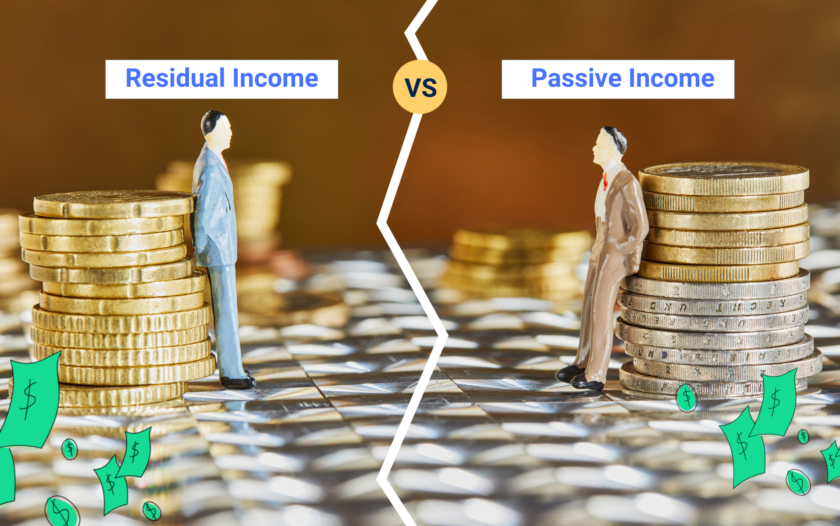What to Know About the Difference Between Passive and Residual Income
About Anouare
Anouare is a seasoned writer, editor and content strategist who started her career as a lifestyle journalist before stepping into leadership roles at publications such as AskMen and Goalcast. From editorial strategy to content marketing and project-management, she has tackled various challenges in digital media and discovered her passion for mentoring others in the process. She loves a good money mindset book and believes you can create your dream lifestyle by being yourself.
Read full bio
When it comes to personal finance, income is a great thing. It ultimately means more money going into your bank account. That said, not all types of income are created equal. Take, for example, passive and residual income. Both of those sources of money can help you grow your net worth in the long run, so it’s important to understand the difference between the two.
20%
Is the number of Americans, according to the most recent U.S. Census data, that earn passive income. Those households bringing in about $4,200 per year through these streams.


What is passive income?
If you have a job, you go to work and earn your paycheck, whether you get paid on an hourly or yearly basis. If you are a freelancer or own a business, your activities translate into sales and revenue, some of which ends up in your pocket. That’s active income. On the other hand, passive income is income that you generate without the same type of effort.
“Passive income has been a term used relatively loosely in recent years. Colloquially, it has been used to define money being earned regularly with little or no effort on the part of the person receiving it,” according to Investopedia.
What are some examples of passive income? Money you earn from investments, properties, or side hustles that require little action on your part. While the IRS doesn’t consider portfolio income as passive, many financial analysts do. So keep in mind that there are nuances between what most people consider passive and how to approach your taxes. Talk to an accountant to clarify how to best deal with your situation from a fiscal standpoint.
Real life example of passive income: Let’s say you have a rental property. After accounting for expenses like mortgage, property management, and maintenance, you earn a net monthly rental income of $400. Over a year, that’s $4,800 in passive income from the property. While there’s initial work in purchasing and setting up the property, the monthly income requires relatively less active effort.
What is residual income?
From debt payments to your rent and mortgage and other essentials, the money going into your bank account also gets spent on a regular basis. Residual income, which is often also called discretionary or disposable income, is the income left after you’ve paid off your debts and obligations. The more residual income you have, the more you can save, invest, or spend towards purchases that are “nice-to-have” but not critical, such as going on a vacation.
If you run a business, residual income is essentially what’s left after you’ve covered all the costs associated with running that business – it’s your leftover profit.
Residual income matters when you’re borrowing money, as lenders will often use it to determine whether you can comfortably cover your monthly payments.
Real life example of residual income: Let’s say you’ve built a portfolio of rental properties. After accounting for all expenses (mortgage, property management, maintenance, taxes, etc.), the total monthly rental income from your properties is $6,000. While managing your properties does require ongoing effort, let’s break down the residual income aspect:
- Monthly rental income: $6,000
- Monthly expenses (mortgage, maintenance, etc.): $3,500
- Residual income: $6,000 – $3,500 = $2,500 per month
In this scenario, you’re earning $2,500 in residual income every month. This income continues to come in even after covering your expenses, reflecting the ongoing benefits of your initial investment in real estate. Over a year, this would amount to $30,000 in residual income.
Passive vs. residual income
Residual income can be passive income, but not all passive income is residual. OK so how does that work? You may end up with extra money in your bank account each month because of a source of money that requires little work on your part. If you manage to create residual income from passive income, you’re winning. In other words, it’s possible to have both and it’s a desirable scenario.
However, you can have passive income and end up having very high monthly expenses where all your passive income goes towards bills. That will help you cover your bases but you ultimately want to be growing that discretionary income to really make a dent in your finances.
To sum it up, while both passive income and residual income involve earning money without a constant active presence, passive income tends to require less ongoing involvement, while residual income often involves maintaining or nurturing an existing source of income.
Bottom line
When it comes to improving your finances, both passive and residual income are desirable sources of income. The key differences between the two lie in how you earn the money and what you do with it.









